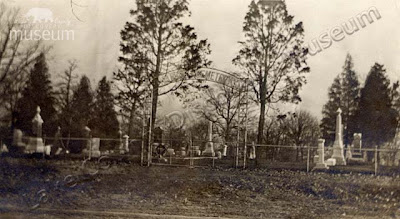George K. Spoor (1871-1953), founded Essanay Studios in Chicago in 1907 with Gilbert "Broncho Billy" Anderson (1880-1971). The name Essanay was derived from the initials of the men's surnames "S and A."
Essanay logo as seen on promotional lantern slides used at theaters, circa 1915. (Dunlap Collection 64.32, Bess Bower Dunn Museum)
Spoor landed in the movie business after managing Edward Amet's (1861-1945) Magniscope and film distribution business out of Waukegan in the 1890s. When Amet quit the business, Spoor went to Chicago to found a film studio.
Although Essanay Studios had a relatively short run in the business (1907 - circa 1918), they employed some of the most famous silent film actors to grace the silver screen: Francis X. Bushman, Wallace Beery, Gloria Swanson (a Chicago native), Charlie Chaplin, and the often overlooked Max Linder.
Charlie Chaplin signed with Essanay in 1915 (after his contract ended with the Keystone Film Company) for an unprecedented $1,250 per week and a $10,000 signing bonus. Chaplin made fourteen films with Essanay, although only the first one, "His New Job," was filmed at Essanay's Chicago studio located at 1343-45 West Argyle Street.
 |
| Movie still from "His New Job" starring Ben Turpin (left) and Charlie Chaplin. Released by Essanay February 1, 1915. |
 |
| Promotional lantern slide for Chaplin's first Essanay film "His New Job." Dunlap Collection 64.32.29, Bess Bower Dunn Museum. |
The most celebrated of the Essanay comedies, "The Tramp" (released: April 11, 1915) is regarded as the first classic Chaplin film. Of course, the Tramp character also made Chaplin an icon.
Even after Chaplin left Essanay Studios, which had relocated to Hollywood, California, the studio continued to release "new" Chaplin comedies using old film clips and out-takes. This practice became common with entrepreneurs trying to sate the demand for Chaplin's films, despite the long wait before his next feature was released. Chaplin was such a perfectionist that it sometimes took a year or more for him to finish a film.
With Chaplin's departure, Essanay needed a new comedian. They turned to French comedic actor, Max Linder. Interestingly, Chaplin considered himself a "student" of Linder whom he called "the great master."
 |
| Max Linder, circa 1916. Essanay Collection, Bess Bower Dunn Museum. |
In the pre-World War I silent film era, Max Linder (1883-1925) was number one at the box office. By 1910, he was an internationally popular comedian with his character “Max, the dapper dandy.” Wearing a suit and top hat, the dandy lived in luxury, but continually got into funny situations.
In 1914, Linder’s career was put on hold when World War I began in Europe. He enlisted with the French army, and suffered illness from gas poisoning. By 1916, he had recovered, and signed the contract with Essanay Studios in the United States.
 |
| Colorized glass lantern slide showing a scene from Max Linder's "Max in a Taxi." Essanay Studios 1916. Dunlap Collection 64.32.31, Bess Bower Dunn Museum. |
Linder only made three films with Essanay when his health failed once again and he was forced to take a year off. When he returned to films, Charlie Chaplin had taken over as the biggest box office draw. However, Linder's “mirror gag” in which he mirrors the action of another character was resurrected by the Marx Brothers in their 1933 film, “Duck Soup.”
 |
| Max Linder as "Max the dapper dandy" in his famous pose. Still from Essanay Studio's "Max in a Taxi" 1916. Essanay Collection, Bess Bower Dunn Museum. |
Although only 105 of Max Linder’s 500 movies have survived, silent movie fans are re-discovering his charm, and critics are acknowledging his great contribution to the development of film comedy alongside Charlie Chaplin.






















_small)















